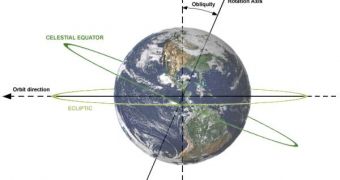New evidence uncovered by experts seems to point out the fact that wobbles in our planet's tilt may have been the triggers behind global warming events that took place in prehistoric times. It has for a long time been known that Earth's tilt in regard to the Sun is not stable, and that our planet wobbles as it revolves around the star. This is the first time evidence that the obliquity of the tilt, and not necesseray its wobble types, are influencing global warming and the planet's climate appear, ABC News informs.
According to a new study, published in the August 14th issue of the respected journal Science, the penultimate ice age did not end when most geologists think it did. Newly uncovered evidence places its end at around 141,000 years ago, which is several thousands of years earlier than first thought. In charge of the research were scientists from the University of Newcastle, in Australia, led by expert Dr Russell Drysdale.
This assumption deserves thorough looking-into, other experts say, because it challenges established knowledge that it was the intensity of summer seasons in the Northern Hemisphere that triggered or stopped ice ages. If it turns out to be true, the conclusions of the new study will be the first to show that it was in fact Earth's orientation towards the Sun that triggered all of this. The information the Australian team published was collected from three Italian stalagmites, which have been almost perfectly preserved.
Drysdale and his colleagues say that the level of obliquity – the tilt of the planet towards the Sun – has the interesting effect of dictating the total amount of sunlight that each of the Earth's two hemispheres receives during the summer. Obliquity however was found not to affect the peak intensity of the solar radiation during the northern summer to a large degree. “Any improvement we can have in understanding how the earth's orbital parameters affect our coming in and out of ice ages can certainly affect the models used now too,” explains University of Melbourne expert Dr John Hellstrom.
The new study also set the researchers on a new avenue for research. They are currently investigating the interesting hypothesis that states glacial melting periods actually began in the Southern Hemisphere, and not in the northern one. Still, at this point, this is all speculation, and more studies are required before this can be established.

 14 DAY TRIAL //
14 DAY TRIAL //